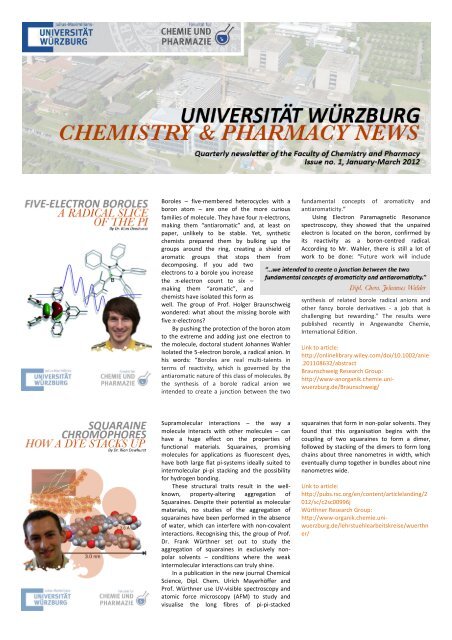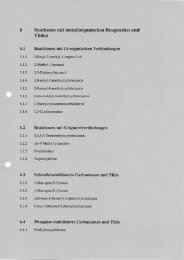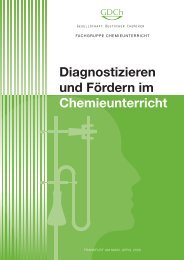Boroles – five-‐membered heterocycles with a boron atom – are on
Boroles – five-‐membered heterocycles with a boron atom – are on
Boroles – five-‐membered heterocycles with a boron atom – are on
You also want an ePaper? Increase the reach of your titles
YUMPU automatically turns print PDFs into web optimized ePapers that Google loves.
<str<strong>on</strong>g>Boroles</str<strong>on</strong>g> <str<strong>on</strong>g>–</str<strong>on</strong>g> <str<strong>on</strong>g>five</str<strong>on</strong>g>-<str<strong>on</strong>g>‐membered</str<strong>on</strong>g> <str<strong>on</strong>g>heterocycles</str<strong>on</strong>g> <str<strong>on</strong>g>with</str<strong>on</strong>g> a<br />
<str<strong>on</strong>g>bor<strong>on</strong></str<strong>on</strong>g> <str<strong>on</strong>g>atom</str<strong>on</strong>g> <str<strong>on</strong>g>–</str<strong>on</strong>g> <str<strong>on</strong>g>are</str<strong>on</strong>g> <strong>on</strong>e of the more curious<br />
families of molecule. They have four π-‐electr<strong>on</strong>s,<br />
making them “antiaromatic” and, at least <strong>on</strong><br />
paper, unlikely to be stable. Yet, synthetic<br />
chemists prep<str<strong>on</strong>g>are</str<strong>on</strong>g>d them by bulking up the<br />
groups around the ring, creating a shield of<br />
aromatic groups that stops them from<br />
decomposing. If you add two<br />
electr<strong>on</strong>s to a borole you increase<br />
the π-‐electr<strong>on</strong> count to six <str<strong>on</strong>g>–</str<strong>on</strong>g><br />
making them “aromatic”, and<br />
chemists have isolated this form as<br />
well. The group of Prof. Holger Braunschweig<br />
w<strong>on</strong>dered: what about the missing borole <str<strong>on</strong>g>with</str<strong>on</strong>g><br />
<str<strong>on</strong>g>five</str<strong>on</strong>g> π-‐electr<strong>on</strong>s?<br />
By pushing the protecti<strong>on</strong> of the <str<strong>on</strong>g>bor<strong>on</strong></str<strong>on</strong>g> <str<strong>on</strong>g>atom</str<strong>on</strong>g><br />
to the extreme and adding just <strong>on</strong>e electr<strong>on</strong> to<br />
the molecule, doctoral student Johannes Wahler<br />
isolated the 5-‐electr<strong>on</strong> borole, a radical ani<strong>on</strong>. In<br />
his words: “<str<strong>on</strong>g>Boroles</str<strong>on</strong>g> <str<strong>on</strong>g>are</str<strong>on</strong>g> real multi-‐talents in<br />
terms of reactivity, which is governed by the<br />
antiaromatic nature of this class of molecules. By<br />
the synthesis of a borole radical ani<strong>on</strong> we<br />
intended to create a juncti<strong>on</strong> between the two<br />
Supramolecular interacti<strong>on</strong>s <str<strong>on</strong>g>–</str<strong>on</strong>g> the way a<br />
molecule interacts <str<strong>on</strong>g>with</str<strong>on</strong>g> other molecules <str<strong>on</strong>g>–</str<strong>on</strong>g> can<br />
have a huge effect <strong>on</strong> the properties of<br />
functi<strong>on</strong>al materials. Squaraines, promising<br />
molecules for applicati<strong>on</strong>s as fluorescent dyes,<br />
have both large flat pi-‐systems ideally suited to<br />
intermolecular pi-‐pi stacking and the possibility<br />
for hydrogen b<strong>on</strong>ding.<br />
These structural traits result in the well-‐<br />
known, property-‐altering aggregati<strong>on</strong> of<br />
Squaraines. Despite their potential as molecular<br />
materials, no studies of the aggregati<strong>on</strong> of<br />
squaraines have been performed in the absence<br />
of water, which can interfere <str<strong>on</strong>g>with</str<strong>on</strong>g> n<strong>on</strong>-‐covalent<br />
interacti<strong>on</strong>s. Recognising this, the group of Prof.<br />
Dr. Frank Würthner set out to study the<br />
aggregati<strong>on</strong> of squaraines in exclusively n<strong>on</strong>-‐<br />
polar solvents <str<strong>on</strong>g>–</str<strong>on</strong>g> c<strong>on</strong>diti<strong>on</strong>s where the weak<br />
intermolecular interacti<strong>on</strong>s can truly shine.<br />
In a publicati<strong>on</strong> in the new journal Chemical<br />
Science, Dipl. Chem. Ulrich Mayerhöffer and<br />
Prof. Würthner use UV-‐visible spectroscopy and<br />
<str<strong>on</strong>g>atom</str<strong>on</strong>g>ic force microscopy (AFM) to study and<br />
visualise the l<strong>on</strong>g fibres of pi-‐pi-‐stacked<br />
fundamental c<strong>on</strong>cepts of aromaticity and<br />
antiaromaticity.”<br />
Using Electr<strong>on</strong> Paramagnetic Res<strong>on</strong>ance<br />
spectroscopy, they showed that the unpaired<br />
electr<strong>on</strong> is located <strong>on</strong> the <str<strong>on</strong>g>bor<strong>on</strong></str<strong>on</strong>g>, c<strong>on</strong>firmed by<br />
its reactivity as a <str<strong>on</strong>g>bor<strong>on</strong></str<strong>on</strong>g>-‐centred radical.<br />
According to Mr. Wahler, there is still a lot of<br />
work to be d<strong>on</strong>e: “Future work will include<br />
synthesis of related borole radical ani<strong>on</strong>s and<br />
other fancy borole derivatives -‐ a job that is<br />
challenging but rewarding.” The results were<br />
published recently in Angewandte Chemie,<br />
Internati<strong>on</strong>al Editi<strong>on</strong>.<br />
Link to article:<br />
http://<strong>on</strong>linelibrary.wiley.com/doi/10.1002/anie<br />
.201108632/abstract<br />
Braunschweig Research Group:<br />
http://www-‐anorganik.chemie.uni-‐<br />
wuerzburg.de/Braunschweig/<br />
squaraines that form in n<strong>on</strong>-‐polar solvents. They<br />
found that this organisati<strong>on</strong> begins <str<strong>on</strong>g>with</str<strong>on</strong>g> the<br />
coupling of two squaraines to form a dimer,<br />
followed by stacking of the dimers to form l<strong>on</strong>g<br />
chains about three nanometres in width, which<br />
eventually clump together in bundles about nine<br />
nanometres wide.<br />
Link to article:<br />
http://pubs.rsc.org/en/c<strong>on</strong>tent/articlelanding/2<br />
012/sc/c2sc00996j<br />
Würthner Research Group:<br />
http://www-‐organik.chemie.uni-‐<br />
wuerzburg.de/lehrstuehlearbeitskreise/wuerthn<br />
er/
Defects in polymeric materials like graphene <str<strong>on</strong>g>are</str<strong>on</strong>g><br />
unavoidable, and often annoying. But in<br />
graphene, defects can change the way the<br />
material resp<strong>on</strong>ds to external stimulus <str<strong>on</strong>g>–</str<strong>on</strong>g><br />
sometimes in desirable ways.<br />
These defects occur in graphene when the<br />
usual h<strong>on</strong>eycomb-‐like pattern of hexag<strong>on</strong>s is<br />
interrupted by pentag<strong>on</strong>s or heptag<strong>on</strong>s. As we<br />
all learn as children, there’s no way to make flat<br />
networks of pentag<strong>on</strong>s or heptag<strong>on</strong>s, so these<br />
defects create blisters in an otherwise dead-‐flat<br />
sheet of carb<strong>on</strong> <str<strong>on</strong>g>atom</str<strong>on</strong>g>s.<br />
To study how such a defect disturbs the<br />
electr<strong>on</strong>ic and magnetic properties of graphene,<br />
the group of Prof. Dr. Anke Krueger has<br />
targetted an isolated, molecular versi<strong>on</strong> of the<br />
irregularity, a “defective graphite flake” <str<strong>on</strong>g>with</str<strong>on</strong>g> a<br />
tribenzotriquinacene core. But while the defects<br />
occur naturally in graphene, synthesising a<br />
molecular versi<strong>on</strong> is very tricky indeed.<br />
Even high-‐school students will tell you that four-‐<br />
coordinate carb<strong>on</strong> is tetrahedral, and this<br />
c<strong>on</strong>cept holds too for carb<strong>on</strong>’s neighbours <str<strong>on</strong>g>bor<strong>on</strong></str<strong>on</strong>g><br />
and nitrogen. However, a new report in<br />
Angewandte Chemie, Internati<strong>on</strong>al Editi<strong>on</strong> from<br />
the research group of Prof. Dr. Holger<br />
Braunschweig suggests otherwise. By attaching<br />
four transiti<strong>on</strong> metals to a <str<strong>on</strong>g>bor<strong>on</strong></str<strong>on</strong>g> <str<strong>on</strong>g>atom</str<strong>on</strong>g>, they<br />
have prep<str<strong>on</strong>g>are</str<strong>on</strong>g>d two complexes in which the<br />
<str<strong>on</strong>g>bor<strong>on</strong></str<strong>on</strong>g> is essentially flat.<br />
The students who performed the syntheses,<br />
Dr. Katharina Kraft and Dipl. Chem. Sebastian<br />
Östreicher, spent over a year trying to add the<br />
crucial fourth metal fragment to the <str<strong>on</strong>g>bor<strong>on</strong></str<strong>on</strong>g> <str<strong>on</strong>g>atom</str<strong>on</strong>g>,<br />
but did not expect that both complexes would<br />
turn out to be planar.<br />
As Mr. Östreicher<br />
explains, “The sheer fact that<br />
coordinati<strong>on</strong> of four metal<br />
<str<strong>on</strong>g>atom</str<strong>on</strong>g>s to <str<strong>on</strong>g>bor<strong>on</strong></str<strong>on</strong>g> was even<br />
possible came as a big<br />
surprise to us.” Since forcing <str<strong>on</strong>g>bor<strong>on</strong></str<strong>on</strong>g> to c<strong>on</strong>tort<br />
and form unsual geometries is a founding<br />
principle of the Braunschweig research group,<br />
The first hurdle to overcome was the<br />
synthesis of a tribenzotriquinacene <str<strong>on</strong>g>with</str<strong>on</strong>g> six<br />
substituents at para-‐positi<strong>on</strong>s (i.e. the porti<strong>on</strong><br />
shown in black in the figure). After much<br />
tribulati<strong>on</strong>, two variati<strong>on</strong>s of the desired<br />
structure were isolated, and their progress has<br />
recently been published in the journal Chemical<br />
Communicati<strong>on</strong>s. The next step in the process,<br />
c<strong>on</strong>necting the three <str<strong>on</strong>g>are</str<strong>on</strong>g>ne rings to create three<br />
more rings, beck<strong>on</strong>s.<br />
Link to article:<br />
http://pubs.rsc.org/en/c<strong>on</strong>tent/articlelanding/2<br />
012/cc/c1cc14703j<br />
Krueger Research Group:<br />
http://www-‐organik.chemie.uni-‐<br />
wuerzburg.de/lehrstuehlearbeitskreise/krueger/<br />
startseite/<br />
what is next <strong>on</strong> the list? “I really would love to<br />
see some<strong>on</strong>e trying to add a fifth metal to the<br />
<str<strong>on</strong>g>bor<strong>on</strong></str<strong>on</strong>g>”, said Mr. Östreicher.<br />
Link to article:<br />
http://<strong>on</strong>linelibrary.wiley.com/doi/<br />
10.1002/anie.201107248/abstract<br />
Braunschweig Research Group:<br />
http://www-‐anorganik.chemie.uni-‐<br />
wuerzburg.de/Braunschweig/





